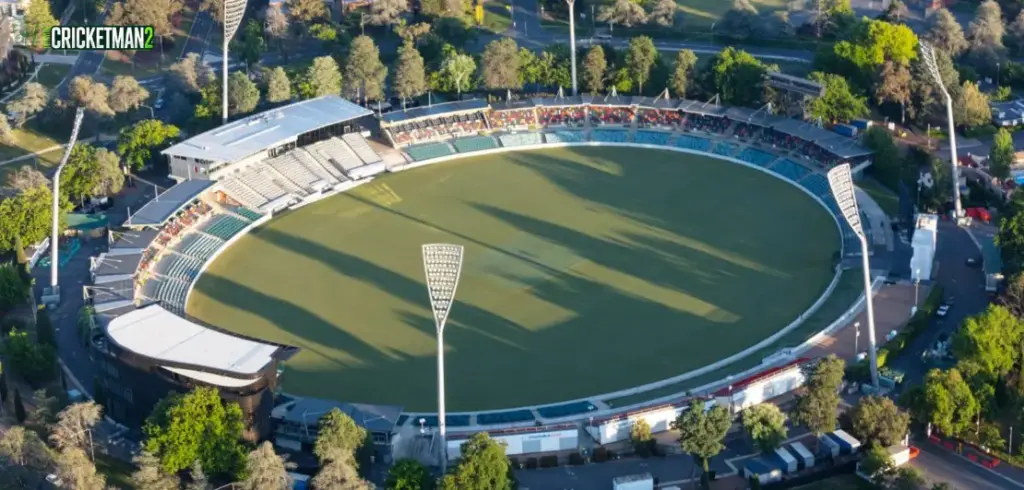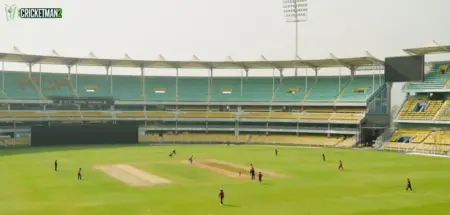The Australian cricket team will be looking to use their momentum from the recent ODI series win as they prepare for the 1st T20I to be played at the Manuka Oval in Canberra. In this article, we take a look at the Manuka Oval Pitch Report, whether it is batting friendly or bowling friendly.
The Australian team won the recent 3 match ODI series 2-1 winning the first two matches before losing the 3rd. Now Australia and India are set to play a total of 5 T20I matches as part of their preparation for the upcoming T20 World Cup 2026 in India and Sri Lanka.
The first of the five match series is set to take place at the Manuka Oval on Wednesday, October 29. The match will commence from 1:45 P.M Indian Standard Time (IST).
The host Australian team is coming into this T20I series on the back of a 2-0 series win in a 3 match series vs New Zealand. After this, Australia will switch from the shortest format to the longest format for the upcoming The Ashes series vs England.
Meanwhile, Team India led by captain Suryakumar Yadav, is coming into this series on a great run of form and momentum after having won the T20 Asia Cup 2025 beating arch-rivals Pakistan in the final.
Both the sides are stacked with quality players for the shorter format of the game and it promises to be an exciting series. And it all starts off at the Manuka Oval. Find below the Manuka Oval Pitch Report for Australia vs India 1st T20I match.
Manuka Oval Pitch Report – Batting or Bowling Pitch?
| Stadium Name | Manuka Oval |
| Location | Canberra, Australia |
| Opened On | 1929 |
| Seating Capacity | 15,000 (12,000 for cricket) |
| Boundary Size (Straight) | Around 80 meters |
The Manuka Oval Stadium is a multipurpose stadium situated in the capital city of Australia, Canberra. The ground is mostly used for cricket and Australian rules football. Built in 1929, the ground has an overall capacity of 15000 and approximately 12000 for cricket.
The Manuka Oval, formerly known as Manuka Circle Park, is quite a popular venue to conduct T20 International cricket for Australia’s home games.
The Manuka Oval Pitch Report suggests that the group is suited for T20 cricket as there is proper competition between bat and ball. The batters though get an extra advantage from the surface. The true bounce from the pitch helps the batters in stroke play. But it is crucial for the batters to not throw away their wickets in the initial phase when the ball still has shine left.
Manuka Oval Pitch Report – Fast Bowlers or Spinners Pitch?
As for the bowlers, they are not completely out of the game. Although the bounce helps the batters in their stroke play, hit the deck bowlers with pace on the offer can be dangerous particularly with the new ball, particularly in the 1st innings when the surface is the hardest in the entire game.
Pace bowlers could surprise batsmen with change of pace and bouncers. For the spinners, the biggest positive is that the boundaries are longer than average, so it won’t be easy to clear the ropes. But the spinners will have to try to keep it slow, making it harder for the batters to smash the ball.
In short, the Manuka Oval pitch report is clear that the batters will be in advantage as true bounce allows the batters in their stroke play. Pace bowlers can be effective with hit the deck line and length and change of pace. Spinners can be effective by bowling slowly and asking the batters to use their mass power to clear the longer than average boundaries. There is no particular advantage for chasing teams and it is going to be an open competition between bat and ball.
See Also:- Cricket Stadiums with the Biggest Boundaries in the World
Manuka Oval – Test Records
| Category | Details |
|---|---|
| Total Matches | 2 |
| Matches won batting first | 1 |
| Matches won bowling first | 0 |
| Average 1st innings Score | 435 |
| Average 2nd innings Score | 256 |
| Average 3rd innings Score | 206 |
| Average 4th innings Score | 197 |
| Highest total recorded | 534/5 (132 Ovs) – AUS vs SL |
| Lowest total recorded | 149/10 (51 Ovs) – SL vs AUS |
| Highest score chased | 0/0 (0 Ovs) – By vs |
| Lowest score defended | 149/10 (51 Ovs) – SL vs AUS |
Manuka Oval – ODI Records
| Category | Details |
|---|---|
| Total Matches | 20 |
| Matches won batting first | 15 |
| Matches won bowling first | 5 |
| Average 1st innings Score | 261 |
| Average 2nd innings Score | 196 |
| Highest total recorded | 411/4 (50 Ovs) – RSA vs IRE |
| Lowest total recorded | 86/10 (24.1 Ovs) – WI vs AUS |
| Highest score chased | 230/8 (49.5 Ovs) – AUSW vs RSAW |
| Lowest score defended | 167/9 (60 Ovs) – AUSW vs NZW |
Manuka Oval – T20I Records
| Category | Details |
|---|---|
| Total Matches | 22 |
| Matches won batting first | 10 |
| Matches won bowling first | 9 |
| Average 1st innings Score | 150 |
| Average 2nd innings Score | 126 |
| Highest total recorded | 195/3 (20 Ovs) – RSAW vs THAIW |
| Lowest total recorded | 82/10 (19.1 Ovs) – THAIW vs RSAW |
| Highest score chased | 181/6 (19 Ovs) – ENGW vs AUSW |
| Lowest score defended | 144/10 (19.5 Ovs) – ENGW vs AUSW |
FAQ:
Is Manuka Oval Batting or Bowling Friendly?
The Manuka Oval in Canberra is a suitable venue for T20 cricket. The true bounce on the offer surface helps batters to play their shots comfortably. However, pacers with the new ball can be effective while the spin bowlers could bowl it slow and take advantage of the longer than average boundary size.
What is the average score at Manuka Oval Stadium?
In T20 International cricket, the Manuka Oval is a fairly high scoring venue. The first innings average score here is 150 which goes down to 126 runs in the 2nd inning. It clearly indicates that we are going to see some cracking action between bat and ball.
What are the boundary dimensions at Manuka Oval?
The Manuka Oval is a fairly big ground. The boundary dimensions are bigger than a normal Indian stadium boundary. The square boundaries are approximately 75 meters while the straight boundaries are approximately 80 meters long.




